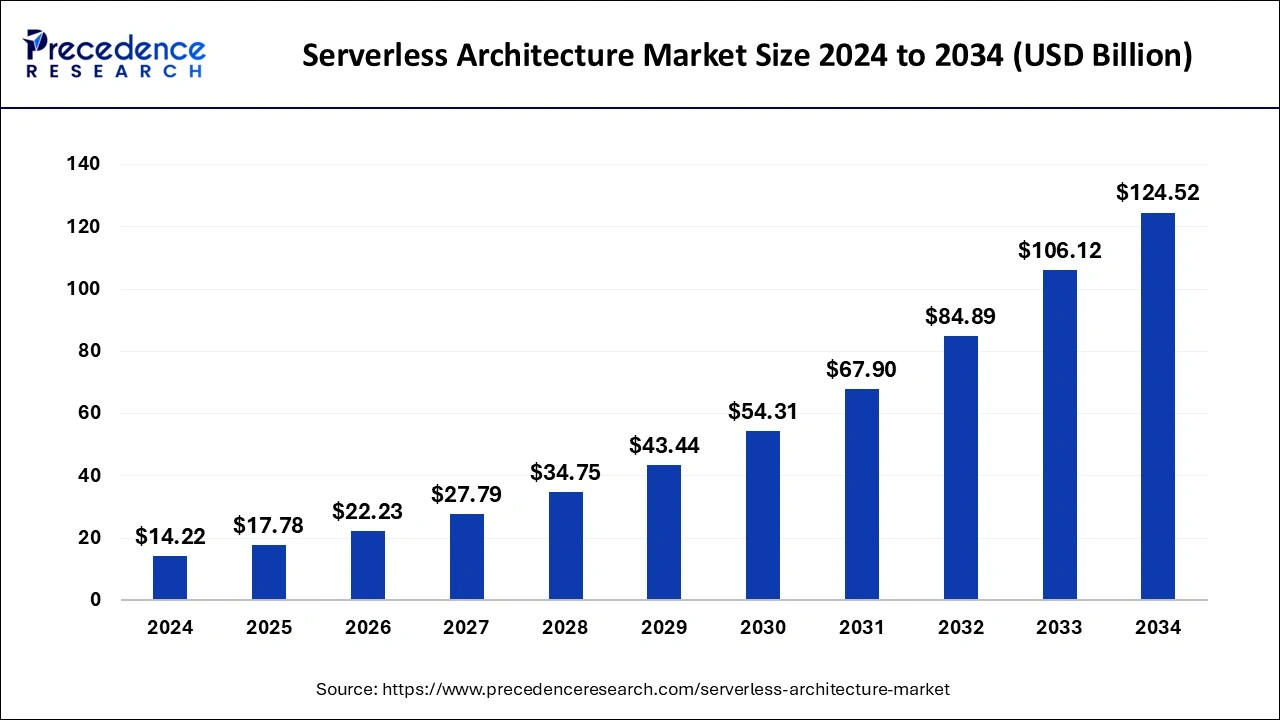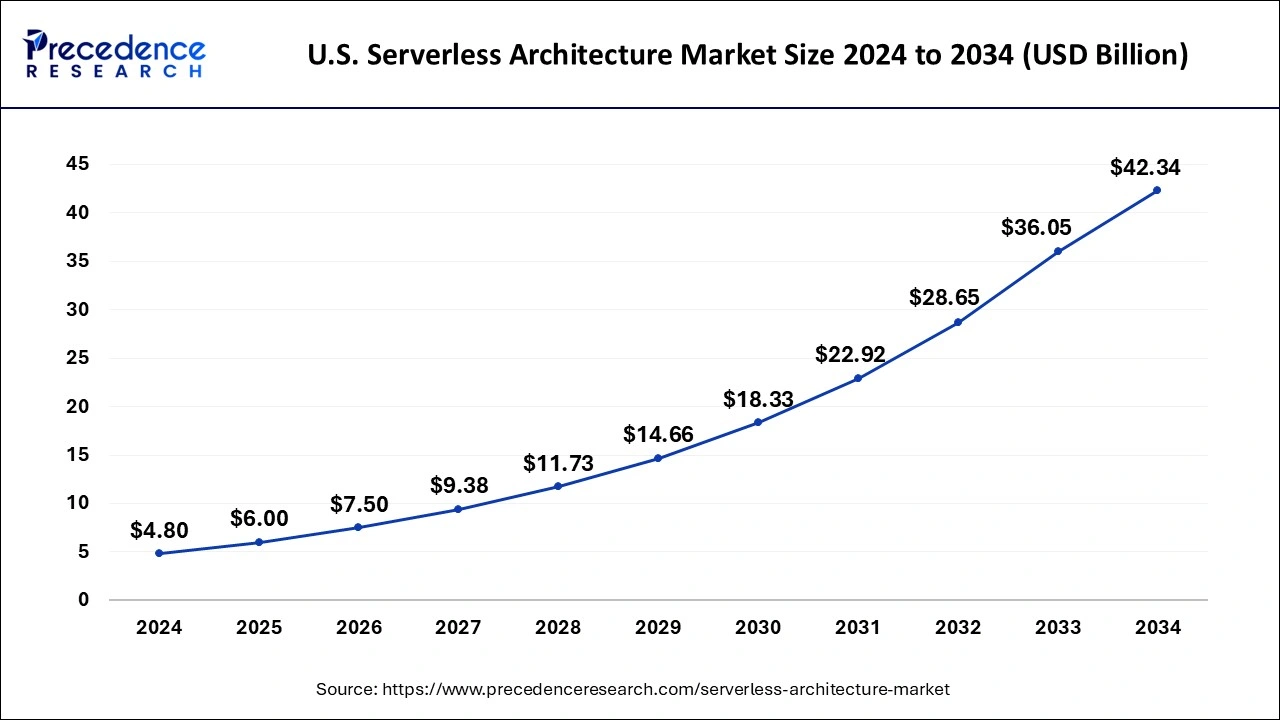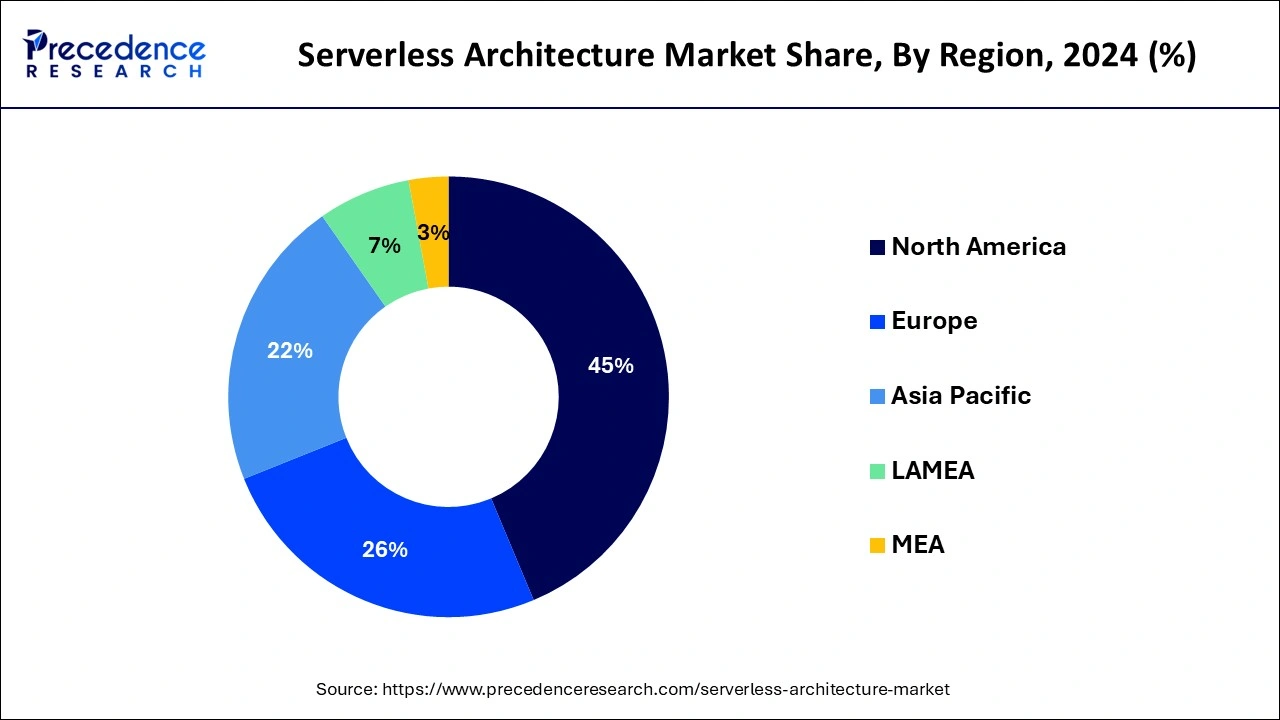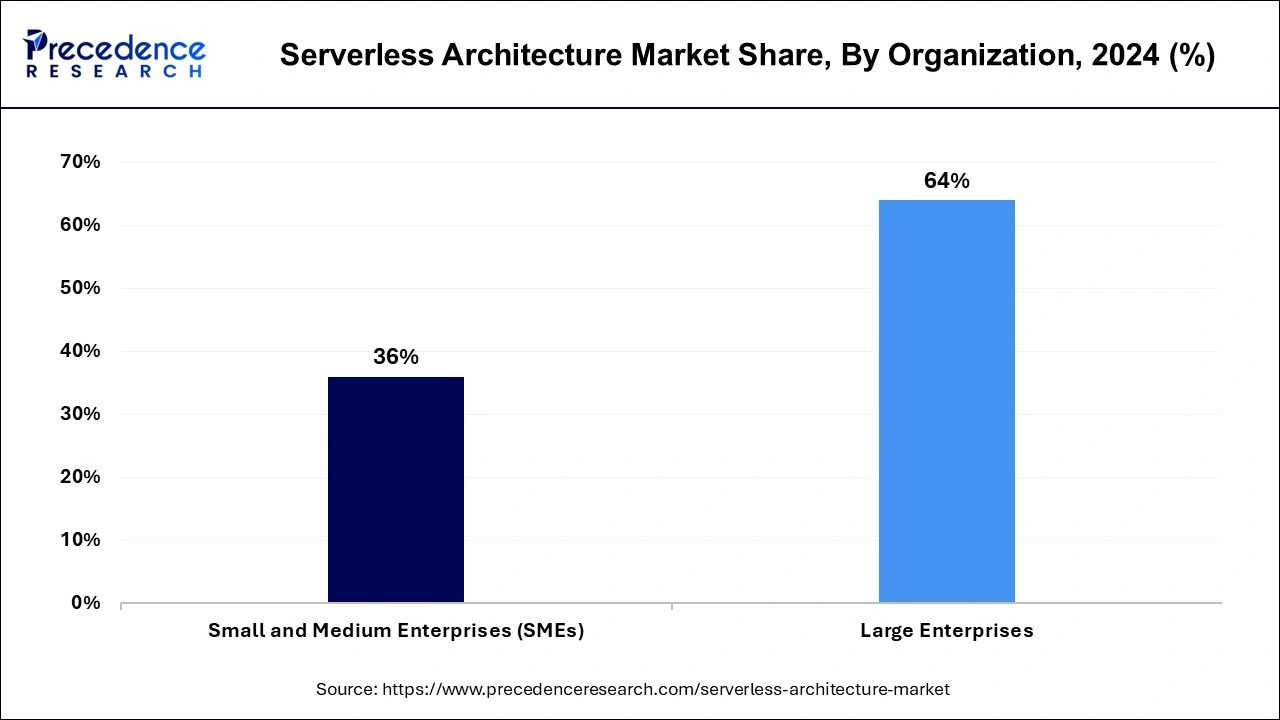July 2024
The global serverless architecture market size is calculated at USD 17.78 billion in 2025 and is forecasted to reach around USD 124.52 billion by 2034, accelerating at a CAGR of 24.23% from 2025 to 2034. The North America serverless architecture market size surpassed USD 6.40 billion in 2024 and is expanding at a CAGR of 24.26% during the forecast period. The market sizing and forecasts are revenue-based (USD Million/Billion), with 2024 as the base year.
The global serverless architecture market size was estimated at USD 14.22 billion in 2024 and is predicted to increase from USD 17.78 billion in 2025 to approximately USD 124.52 billion by 2034, expanding at a CAGR of 24.23% from 2025 to 2034. The increasing adoption of software-based technologies in industries is driving the growth of the market.

The U.S. serverless architecture market size was estimated at USD 4.80 billion in 2024 and is predicted to be worth around USD 42.34 billion by 2034, at a CAGR of 24.32% from 2025 to 2034.

North America led the serverless architecture market, with the largest market size in 2024. The growth of the market in the region is increasing due to the rising IT infrastructure, and the increasing demand for scalable solutions in server management is driving the growth of the market. The increasing presence of leading tech giants like Amazon, Google, and Microsoft in the United States is contributing to the expansion of the market. Additionally, the rising technological adoption in various industrial applications is also boosting the growth of the market. The rising investments in infrastructural development in the United States and Canada and investments in research and development activities for product launches are driving the growth of the market across the region.

Asia Pacific is observed to witness the fastest rate of expansion in the serverless architecture market during the forecast period. The rapid growth of serverless architecture in the Asia Pacific region reflects the increasing adoption of cloud computing technologies and the need for scalable and cost-effective solutions. As businesses in the region strive to innovate and remain competitive, they are turning to serverless computing to streamline their operations, reduce infrastructure management overhead, and improve agility. Additionally, the proliferation of mobile devices and internet connectivity in the Asia Pacific region further drives the demand for scalable and responsive cloud services, making serverless architecture an attractive option for businesses looking to meet the needs of their customers efficiently.
The serverless architecture market provides serverless services, which is a type of software design that allows developers to design and build services without managing the primary infrastructure. Serverless architecture allows the designer to deploy code and the cloud provider provisions to run their applications, storage, and databases at any scale. Function as a Service (FaaS) is one of the most popular serverless architectures. In recent times, most developers have also used AWS Lambda to build serverless applications. Google and Microsoft also have their own FaaS offering, such as Google has Google Cloud Functions (GCF) and Microsoft has Azure Functions, respectively.
The serverless architecture market refers to the industry surrounding the development, deployment, and use of serverless computing technologies and services. Serverless architecture, also known as Function as a Service (FaaS), is a cloud computing model where the cloud provider dynamically manages the allocation and provisioning of servers. In this model, developers focus on writing and deploying code (functions) without needing to manage the underlying infrastructure such as servers, scaling, or maintenance.
| Report Coverage | Details |
| Growth Rate from 2025 to 2034 | CAGR of 24.23% |
| Market Size in 2025 | USD 17.78 Billion |
| Market Size by 2034 | USD 124.52 Billion |
| Largest Market | North America |
| Base Year | 2024 |
| Forecast Period | 2025 to 2034 |
| Segments Covered | By Service, By Deployment Model, By Organization Size, and By Application |
| Regions Covered | North America, Europe, Asia-Pacific, Latin America, and Middle East & Africa |
Increasing demand from organizations
There are several benefits associated with the serverless architecture in organizational operations; it can help to manage and streamline operations, reduce costs, and increase the agility of business operations. In serverless architecture, organizations only pay for the actual processing time of code uses, which can directly reduce infrastructural costs. It automatically scales the applications to the incoming traffic response. The adoption of serverless architecture allows developers to be more focused on writing codes and less on managing servers, which can increase productivity and efficiency and allow faster time to the market. It is the organic fit for the microservices architecture; it enables each function to be scaled and deployed independently. Serverless architecture can reduce latency and enhance user experience. Thus, all these factors drive the growth of the serverless architecture market.
Lack of expertise
The relative complexities in serverless architecture, the lack of skilled technological expertise in the field of serverless architecture, and the risk associated with serverless architecture are restraining the growth of the serverless architecture market.
Rising adoption of technologies
The increasing adoption of technologies like web and mobile applications, IoT (Internet of Things), and real-time data processing. Serverless architecture is a well-suited technology for web and mobile applications, and developers focus on designing the functions and features without being pressured by server management. The server architecture allows developers to develop and deploy faster and enables organizations to deliver scalable and responsive applications for end users. In IoT devices, the serverless architecture enables the major solution for handling real-time data processing and device integration. Serverless architecture is also used in real-time data processing. Thus, the rising technological adoption will contribute to the expansion of the serverless architecture market in the upcoming period.
The automation and orchestration segment dominated the market in 2024. The increasing implementation of the serverless architecture in the automation and orchestration services to streamline operations drives the demand for the segment. Automation allows the execution of various tasks without any human intervention. Orchestration helps the automation process maintain and manage workflow systematically. The rising industrialization and the rapid growth in the large database and workflow requirements are driving the demand for higher efficiency solutions to reduce latency and increase efficiency in operations, driving the demand for serverless architecture in automation and orchestration. Additionally, the rising adoption of automation and orchestration in the IT industry is enhancing the growth of the serverless architecture market.
The private deployment segment is expected to grow at the fastest rate during the forecast period. The growth of the segment is increasing due to the rising adoption of private deployment of serverless architecture and the flexibility offered by private deployment. Private deployment provides more security to projects or applications. Organizations can host private deployment on-premises or manage it by third-party service providers.
The large enterprise segment dominated the serverless architecture market in 2024. The growth of the segment is attributed to the benefits of serverless architecture offered to large enterprises, which drives the growth of the segment. The serverless architecture provides more flexibility and efficiency in operations and reduces the processing cost of the organizations.

Serverless architecture also provides advantages to applications such as data processing and real-time web applications, and the increasing focus on reducing or eliminating server management is boosting the growth of the market. The increasing competition in large enterprises and government interventions is accelerating the growth of the market.
The healthcare segment dominated the serverless architecture market in 2024. The growth of the segment is attributed to the higher adoption of technologies in the healthcare industry, which is driving the expansion of serverless architecture in the healthcare sector. The rising adoption of technological evaluations such as telehealth, telemedicine, and remote healthcare services enhance the health IT infrastructure that drives the demand for efficient solutions for the efficient workflow that drives the growth of the market.
The serverless architecture offers high-end solutions for the effective operation of high-traffic telehealth apps and other healthcare platforms. The increasing investments in the expansion of the healthcare industry and technological evaluation in healthcare applications are contributing to the expansion of the market.
The IT and telecom segment is observed to witness a significant rate of growth during the forecast period. IT and telecom companies often deal with fluctuating workloads and spikes in demand. Serverless architecture allows them to scale their applications dynamically based on demand without worrying about managing server infrastructure. This scalability is crucial for handling large volumes of data and user traffic that are common in these industries. By offloading server management tasks to cloud providers, IT and telecom companies can focus more on developing and improving their core products and services. This allows them to innovate more rapidly and stay competitive in a fast-paced industry.
By Service
By Deployment Model
By Organization
By Application
By Geography
For inquiries regarding discounts, bulk purchases, or customization requests, please contact us at sales@precedenceresearch.com
No cookie-cutter, only authentic analysis – take the 1st step to become a Precedence Research client
July 2024